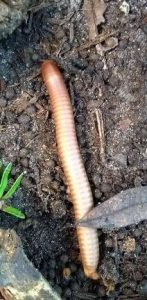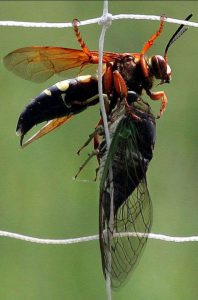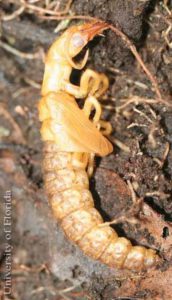Article by Kaydie McCormick, Residential Horticulture Agent & Master Gardener Volunteer Coordinator and amazing arthropods identifier at the UF/IFAS Extension in Seminole County.
Amazing Arthropods of Florida
During July I had a chance to take off my usual hat of horticulturalist for the county and put on my entomologist cap for Bug Camp here at the Extension Center. We had a week of camp with children ages 9 – 12 and a week of camp with teens ages 13-18. We taught the kids everything from what a pollinator is, to with the teens, how to pin and curate an insect collection. A large part of teen camp was working on identifying insects and other amazing arthropods – as we hope to take a team of teens to the Insectathon in Gainesville this January.
I’m always amazed by what a dedicated team of kids can find while catching insects outside. I want to share our four most interesting arthropods found during Bug Camp, and a little bit about where you can find them, how they might interact with our gardens, and some of the wonder I was able to experience while digging around for insects with our campers.
Amazing Arthropod One: American Giant Millipede (Narseus americanus)

One of the largest millipedes found naturally in the United States, the American Giant Millipede can grow between 3-4 inches long. These peaceful detritivores (decay eaters), work hard to break down fallen leaves, wood, and other dying vegetation and create castings (poo!), that is a great source of nutrients for the plants that grow where they live. Most millipedes produce many eggs that they take care of, but the American Giant produces only one at a time. Several of our campers found millipedes, but only one managed to find an American Giant Millipede! It is now being kept in a nice habitat, pampered by Anna. You can read more information about the American Giant Millipede [here].
Amazing Arthropod Two: Cicada Killer (Sphecius speciosus)

I usually spend some time catching bugs before bug camp, just to make sure the teens have some good specimens to pin, and one of the insects that I found was the Cicada Killer. These wasps are some of the largest found in Florida, growing up to an inch and a half in length. Cicada killers do just what their name suggests! These wasps prey on cicadas, catching them and storing them underground where their larvae can eat the captured insects. Their burrows can be over four feet long! These wasps are generally not aggressive, and as long as you don’t bother them, they wont bother you! More information [here].
Amazing Arthropod Three: Hellgrammite (Corydalus cornutus)

One of the craziest looking insects was found by Anna, one of our teens, during a fieldtrip to the Markham Woods Trailhead. Near the stream at the end of the trail she dug up a Hellgrammite, which is the larval form of the eastern dobsonfly. Hellgrammites are generally one of the signs of good water quality and a species that are looked for when doing water quality testing! Pictured here is the stage Anna found her hellgrammite in, which is just getting ready to pupate into an adult. While the larvae live in the water, the pupae and the adults are both found on land. You can see some images of adult dobsonflies [here].
Amazing Arthropod Four: Horned Passalus Beetle (Odontotaenius disjunctus)

The Horned Passalus beetle is a gentle insect that can be found living in decaying trees, making them another important detritivore, like the millipede discussed above. They are also known as the betsy beetle or patent leather beetle, which are both adorable names. Our Passalus beetle was found during our kid camp near a pile of decaying oak branches, and was particularly fascinating to the kids because it can stridulate and make a small squeaking noise [listen here]. Stridulation is when an insect rubs two body parts together to make a sound, like crickets and their wings. Passalus beetles often live in groups inside a log and will compete for the best location to rear their larvae within the wood! You can read more about them [here].
We’ll be doing bug camp again next summer, so if you find an Amazing Arthropod you want identified, please bring it in to the Extension Center in Sanford. Some of them, like the millipede and passalus beetle make great insect ambassadors for the kids to interact with. Others, like our cicada killer, are awesome insects for the kids to practice their identification and pinning skills on. For more information on how to get involved with our 4-H programming, check out our website [here].
 0
0
